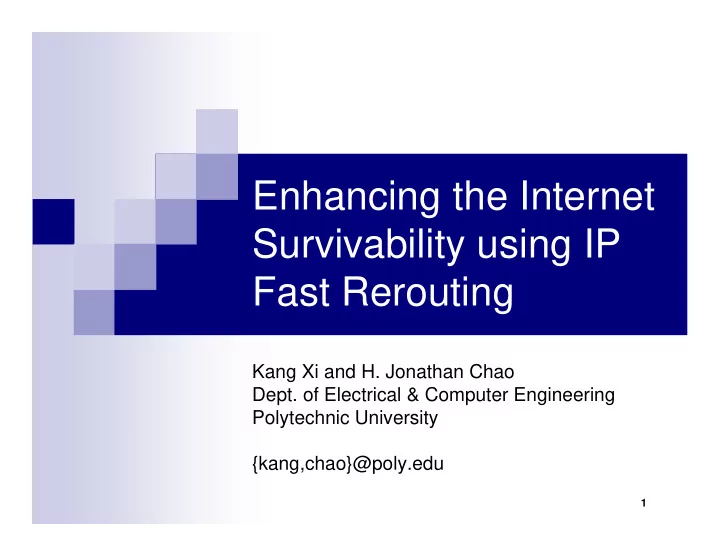

Enhancing the Internet Survivability using IP Fast Rerouting Kang Xi and H. Jonathan Chao Dept. of Electrical & Computer Engineering Polytechnic University {kang,chao}@poly.edu 1
Basics of IP Routing � Find the src/dst paths for packet forwarding � Paths to the same dst form a tree 1 1 2 2 3 3 4 4 5 5 6 6 7 7 8 8 9 9 2
What if a failure happens? � Failures are common in networks 1 1 � A failure may affect 2 3 2 3 several paths 4 5 6 4 5 6 � Traditional Recovery: 7 8 7 8 � Advertise the failure � Recalculate all the 9 9 paths � Problem: Slow 3
Failures in Sprint Backbone (2002) 4
What is IP fast re-routing? � Calculate backup paths before failures occur � Use backup paths immediately after a failure is detected � Advantage: fast recovery, highly applicable 5
Challenges � How to find loop-free backup paths? � How to coordinate routers during the recovery? 6
Use the Disjoint Paths in Circuit Switching? Only ONE entry/output port in the routing table for the destination. 7
Existing Work � Relatively new topic � IETF, Cisco, Alcatel are involved in the research � Only a few papers published � Focus on single failures 8
Our Progress � A set of schemes called Efficient SCan for Alternate Paths (ESCAP) � A simple solution for single-link/node failures � A solution to handle double-link failures � No failure advertising required 9
Single-Node Failure Recovery 10
Example: Failure Scenario 1 2 3 4 5 6 7 8 9 10 11 12 13 14 15 16
Example: Search Procedure
Example: Search Procedure
Example: Result
Algorithm � Denote a tree/sub-tree with T(k), where k is the index of the root. � Use depth-first search, for each node k (except the root), do the following: � Introduce a failure to node k � Node k has m k children, denoted as c 1 , c 2 , … c m k . Need to find an exit for each of T(c 1 ), T(c 2 ), … T(c m k ) � Dye the nodes in T(k), all the other nodes are white � Repeat the following two steps until all node are white � Use breadth-first search on T(k), for each node, check if it has a white neighbor � The first hit found an exit for one of T(c 1 ), T(c 2 ), … T(c m k ), dye that sub-tree white
Forwarding Policy 1 2 3 4 5 6 7 8 9
Performance Evaluation
Performance Metrics � Path lengths � Traffic load on each link
Method � Topology � Practical topologies: COST239, NSFNet � Service Demand � 1 Mb/s between any two nodes � Comparison � IPFRR � Shortest path: Normal � Shortest path route recalculation under failure
Topology
Path Length Distribution � Explore all possible failures, observe the distribution of the path lengths
Load on Each Link
Conclusions � Three schemes: single-link, single-link/node, double-link failure recovery, respectively � 100% failure coverage � Proven correctness � Practical to today’s IP networks � Support of multi-path routing. � Future Research � Multi-failure recovery � Failure recovery in inter-domain routing � Survivable topology design � Building a testbed 24
Recommend
More recommend